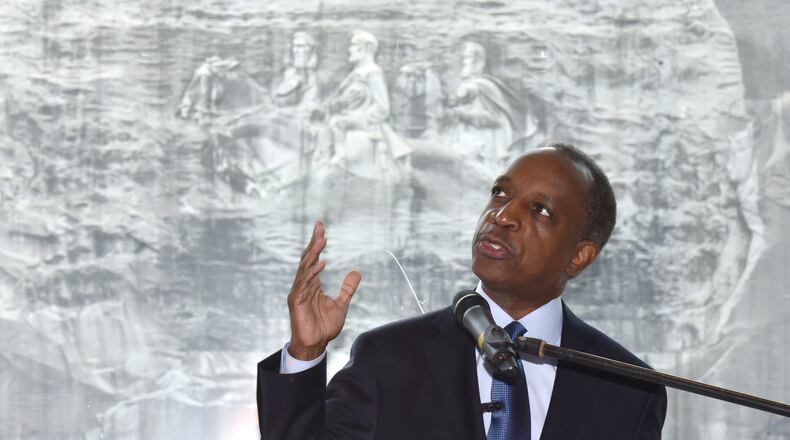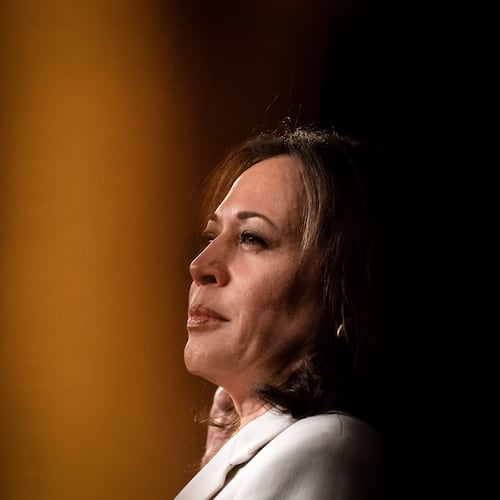You might think that the hazards behind Michael Thurmond's effort to shift the history told at Stone Mountain Park lie on the Republican side, currently the party of choice for most Sons of Confederate Veterans.
And indeed, that’s partly true. There’s opposition there.
But when you are an African-American leader in search of middle ground, trying to pull on that common thread that binds us all, opponents can be found even among your very good friends.
The DeKalb County CEO was on GPB's "Political Rewind" last week, talking about his effort to bring the state-owned park, whose greatest attraction is a lionized carving of three Confederate leaders, into the 21st century.
“I believe that Stone Mountain, properly presented, with a more comprehensive and complete narrative, can continue to be a place that brings people together — as opposed to taking people apart,” Thurmond began.
Georgia’s most popular tourist attraction has developed a built-in conflict of purpose. By act of an all-white Legislature in the 1950s, the mountain and its environs are required to serve as a memorial to the Confederacy. The park is also required to be self-sustaining.
Yet the Confederacy is no longer a commercially viable enterprise in the South. Every time a white supremacist commits an act of evil and waves a Confederate battle emblem to justify it, Stone Mountain Park becomes vulnerable to boycotts and demonstrations.
Thurmond is offering a way out of this dilemma. His price: Abandonment of the myth that the Civil War wasn’t about slavery and its place in America. Leave the carving but acknowledge the uncomfortable fact that, on Thanksgiving Day in 1915, the mountain served as the birthplace of the second iteration of the Ku Klux Klan. And put up that bell tower to mark the Rev. Martin Luther King Jr.’s reference to the mountain in his 1963 “I Have a Dream” speech.
“Much of the pushback and anger and frustration that you receive from African-Americans and others is not about Civil War history,” Thurmond said. “It’s about the substitution of Lost Cause mythology for Civil War history.
“That carving was placed there not as a Civil War monument. It was a monument to the Lost Cause.”
In addition to being DeKalb’s CEO, Thurmond is the only African-American member of the Stone Mountain Memorial Association, the park’s governing body. His board colleagues, who are mostly Republican, have not yet responded to his overtures. Possibly they are waiting for a signal from Gov. Nathan Deal.
GOP support won’t be unanimous. But on that Monday radio show with Thurmond was former Attorney General Sam Olens, a Republican. “Similar to Nazi Germany, there’s no gain in trying to hide what occurred,” Olens said. “But you can always use these as educational moments. I think the CEO is trying to do that, and I think he deserves a lot of praise for it.”
State Sen. Fran Millar, R-Dunwoody, has also endorsed what Thurmond’s doing.
Expect Democrats to be split as well. Two days after Thurmond’s “Rewind” appearance, Stacey Abrams, one of two Democratic candidates for governor, was in our Dunwoody office to discuss her campaign.
In the aftermath of events last year in Charlottesville, Va., Abrams issued a series of provocative tweets on Confederate symbolism. Read one: "(T)he visible image of Stone Mountain's edifice remains a blight on our state and should be removed."
I asked Abrams for her thoughts about what Thurmond is doing, including his position that the carving should not be touched. “I support contextualizing the post-Reconstruction era and what happened through an understanding of history. And I think that’s where CEO Thurmond comes from,” Abrams said. “As a historian, he’s attempting — as the leader of DeKalb County — to strike a balance between his love of history, his understanding of that history there, and the complicated nature of Georgia.”
Credit: Bob Andres
Credit: Bob Andres
This was a good answer. Thurmond, who remains unaligned in the race for governor, leads a county that provides the largest cache of Democratic votes in Georgia.
But what about the mountainside carving of Jefferson Davis, Robert E. Lee and Stonewall Jackson? I asked. Do we just leave it alone, or would you do something with it?
“I would do something with it. I do not believe it should be left to stand as it is, as an unequivocal celebration of domestic terrorism visited upon African-Americans — especially by those who attempted to reignite the KKK in Georgia,” said Abrams, who like Thurmond is black. “I do not support any public funding of their existence, and they should not be given a place of honor on public land.”
Abrams’ position is a principled one, to be sure. But should she become her party’s nominee, the position is one that could prove more than troublesome in a general election climate — especially if her strategy of bringing in new and younger voters falls short.
Afterward, I put in a call to Stacey Evans, Abrams’ rival for the Democratic nomination. Evans, who is white, was at Stone Mountain Park on April 4, the 50th anniversary of the MLK assassination. The program was put together by state Sen. Emanuel Jones, who has endorsed Evans. Thurmond was the keynote speaker.
This week, Evans said in an email that she would let Thurmond cut his deal. (For details, see “DeKalb County, largest cache of Democratic votes.”)
“Georgia is lucky to have him leading the conversation about how best to deal with our state’s painful history, as reflected in how we move forward with Stone Mountain Park,” Evans said. “I look forward to working with CEO Thurmond on this issue and many other critical questions facing Georgia.”
Even in its current state, as Abrams noted, Georgia is a complicated place. Throw in 130 years of slavery, the Civil War, a violent period of Jim Crow suppression, a civil rights movement and a painfully anachronistic piece of public art, and suddenly you’re playing 3-D chess. Lines get crossed.
Two years ago, when talk of that bell tower atop Stone Mountain surfaced, U.S. Rep. Hank Johnson, D-Lithonia, endorsed that idea — and said he opposed destruction of the Stone Mountain carving. He still does. And yet he has also endorsed Abrams in the race for governor.
A day after that MLK ceremony at Stone Mountain Park, the DeKalb County chapter of the NAACP put out a press release explaining its position on the carving. It’s an “insult” and a “blight,” chapter president Teresa Hardy said.
And yet the carving is a fact on the ground that will remain until the political winds shift in the state Capitol, she acknowledged. In the meantime, there are street names that can be changed, plaques that can be erected.
“While you’re building the political will, these are some of the things you can do,” Hardy said.
Perhaps this is why Thurmond’s play seems so risky. In these polarized times, we have forgotten that politics was once known as the art of the possible. You get what you can, while you can. And when times change, if times change, you go back for more.
About the Author
The Latest
Featured





